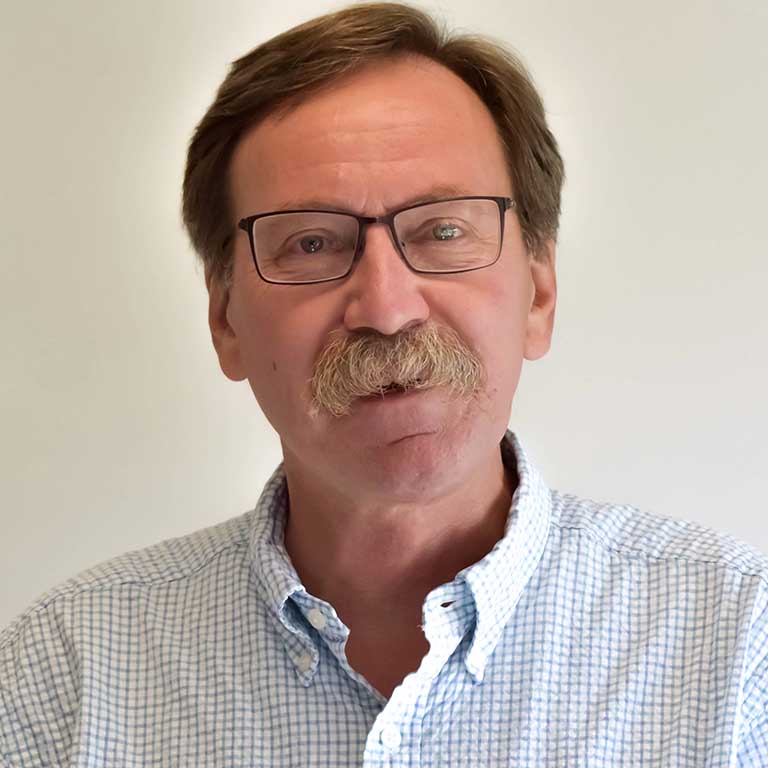- Postdoctoral research scientist, University of Colorado, 1983-1986
- Ph.D., Princeton University, 1983
- M.A., Princeton University, 1979
- A.B., Colgate University, 1977

Bruce Douglas
Emeritus Faculty, Earth and Atmospheric Sciences

Emeritus Faculty, Earth and Atmospheric Sciences
Research interests include the rheological properties of geological materials; stress and strain analysis; fault - fold interactions in field and analog settings; displacement transfer in fault zones; geologic field mapping; laboratory experimentation and measurement of rock fracture strength and time to failure; application of exploration geophysical methods to environmental problems.
At the present time, my research is focused on developing an understanding of various deformation mechanisms that are active in the brittle and ductile portions of the lithosphere. Projects involve both laboratory and field based investigations; all projects typically combine either experimental or theoretical modeling with field or natural samples and site-specific data sets.
A number of field studies are centered in southwestern Montana. One involves studies of the movement history of a set of faults that have been repeatedly reactivated since precambrian time. These faults cut both Archean basement and Paleozoic and Mesozoic cover rocks within the Tobacco Root Mountains. A second study involves mapping and balanced cross section work to determine displacement partitioning as thrusts faults associated with the Cordilleran Fold-and-Thrust Belt are caught up in the Southwest Montana Shear Zone. A third project is focused on the development of Tertiary extensional basins. Normal faults associated with the present compressional extensional regime often disrupt earlier compressional features, in some cases the older fault systems have been reactivated as extensional systems.
I also have a long-term research area investigating the stress within the lithosphere during subduction. This work involves determining the rheological properties of the South American lithosphere above a 1,000-km portion inboard of the Chile Trench. Studies involve petrographic, geochemical, and numerical studies of xenoliths transported to the surface by Quaternary lavas. These direct observations are coupled with Finite Element Modeling of the coupling and mantle flow forces involved in subduction zone geometries.
Several laboratory studies are also in progress documenting the role of subcritical crack propagation during brittle failure of geologic materials. One study involves the propagation of cracks in chemical environments with varying pH, ionic species, and temperature. A second study involves the study of fracture propagation in shales under conditions of hydrocarbon maturation. A third study is directed at computational modeling sub-critical fracture propagation with applications for compound earthquakes, regional joint sets, and thrust fault propagation.
My approach to teaching is intended to provide students with a broadly balanced treatment of basic geologic concepts and definitions with practical applications from both laboratory and field settings. Topics are presented in a manner that intertwines fundamental principles with applications and examples. One critical aspect is to encourage the development of the ability to conduct geometric descriptions and basic descriptions of the problem, or the strain, which provides the what and then couple this with the kinematic aspects of geology and the dynamics or stress conditions that correspond with the strain record (e.g. the how and why). There are two different sets of goals that I to impart. The first set is a mastery of the basic concepts found in geology. The second set is to have a student to be able to take the basic knowledge and apply it to a new setting. This would involve evaluating the geologic setting, setting up testable hypotheses, laying out a series of data gathering steps, and then finally drawing conclusions regarding your initial questions. A major component of this teaching has been my involvement with the field teaching program in Montana. This has included Field Geology in the Northern Rocky Mountains (G429) and Field Geology in the Northern Rocky Mountains with Environmental Geoscience Applications (G429e). I have been at the center of the development of the environmental portions of the programs offered out of the JMGFS. This work has also involved the development of a new course, Introductory Field Experience in Environmental Science (G329).